
In July 2018, I traveled to Gee’s Bend, Alabama to research an exhibition, Piece Together: The Quilts of Mary Lee Bendolph. Mary Lee stands outside her home with two of her children, Rubin Bendolph Jr., and Essie Bendolph Pettway. Essie’s quilts hang on a clothesline behind them.

One of the first exhibits I curated included works by Alice Lok Cahana. Her work bore witness to her experience of surviving concentration camps during the Holocaust and her art was a kaddish for those who did not survive. She communicated that experience to others in ways that were beautiful enough for people to endure. Rather than aestheticizing violence, she used the language of art to engage others. Her mixed-media collages, they don’t preach, yet they convey her profound experience and enduring resilience. Shown above: Cahana’s painting, Waiting for the Magic Bird, acrylic and mixed media on canvas, 84 x 80 inches.
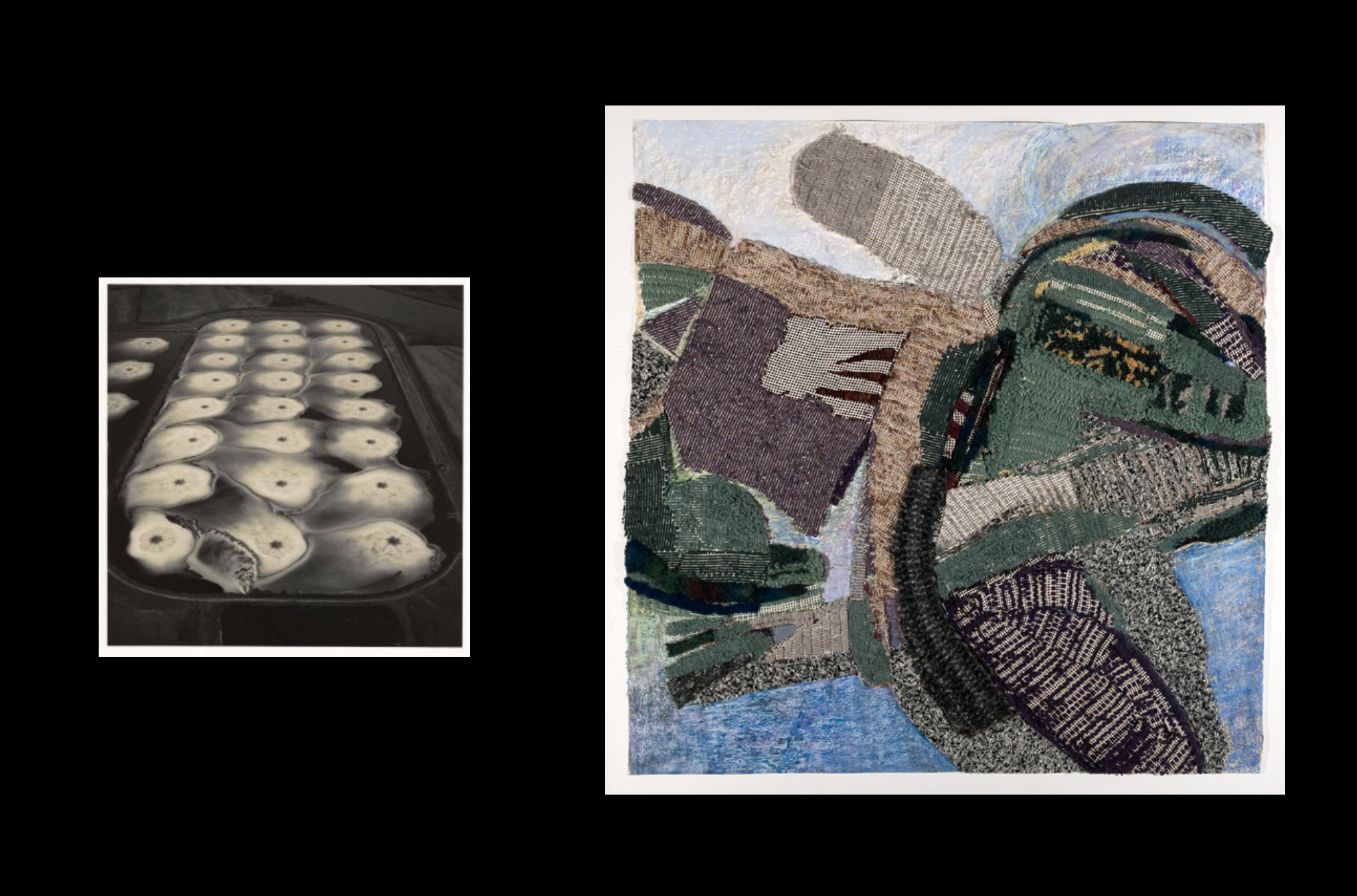
I worked with Emmet Gowin on exhibitions of his photographs at two different venues. His intimate portraits of his family life broadened the conversation about photography in the 1970s. When I hosted a mini-retrospective of his work at the List Gallery, I especially admired his ability to shift his modes of representation. The empathy that he communicated in his family portraits later became apparent in his aerial photographs of sites where human intervention have created toxic conditions.. For instance, he documented the Nevada Proving Ground where we’ve detonated hundreds of atomic explosions, turning the landscape into a kind of moonscape, forever altering the geology of the land. And then, in more recent works, he provides wonderful, intimate, microcosms of nature: he’s inventoried hundreds of moths from Panama, many of them endangered species, and some of them never photographed before. I try to emulate such imaginative elasticity, empathy, and dedication. On the right is Inheritance, a work that took inspiration from Gowin’s aerial perspectives.
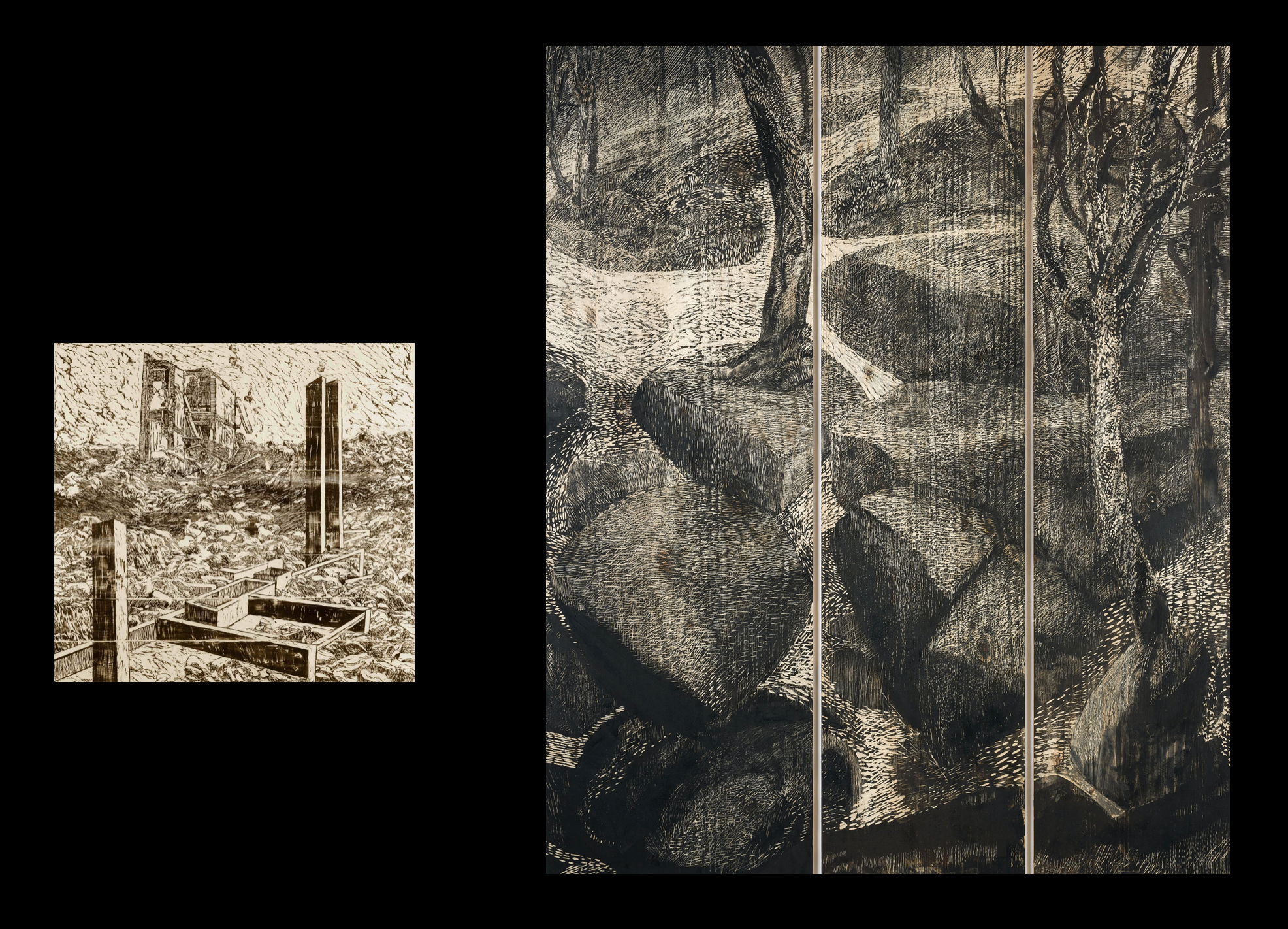
Orit Hofshi and I attended The Pennsylvania Academy of the Fine Arts together many years ago and we both studied woodcut printmaking together. She’s gone on to become an internationally renowned sculptor and printmaker who integrates two-dimensional and three-dimensional practices in her work. After she showed here I went back to my studio and made a six-foot-wide wood carving. It was very different from her work aesthetically, but she had reawakened my love of wood.
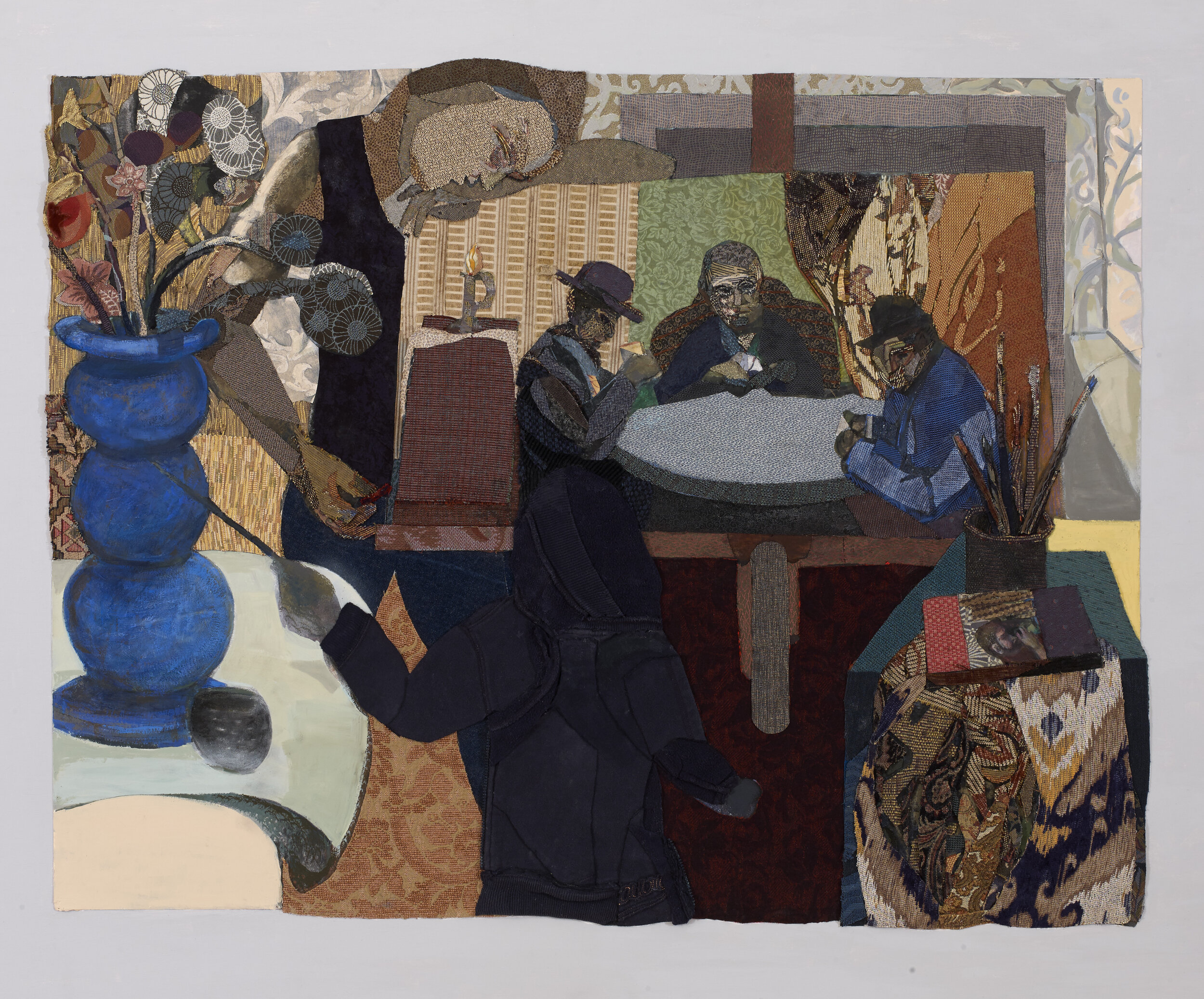
I have taken inspiration from Romare Bearden who, in turn, took inspiration from Cezanne, among others. The above art work is my own homage to Bearden. I am curious about how to harmonize different influences–how one aesthetic can help transform another. For example, I am fascinated by the way introducing fabric into a work might change the way we experience space. Or introducing a different medium like pastel into a painting can evoke a shift in perception. Conversations between different aesthetics, inspirations, and media can echo the way consciousness is multilayered. It’s not unified by a single mode or look or source. It’s an elastic process of shifts through which we see, revise, and recreate the world around us.
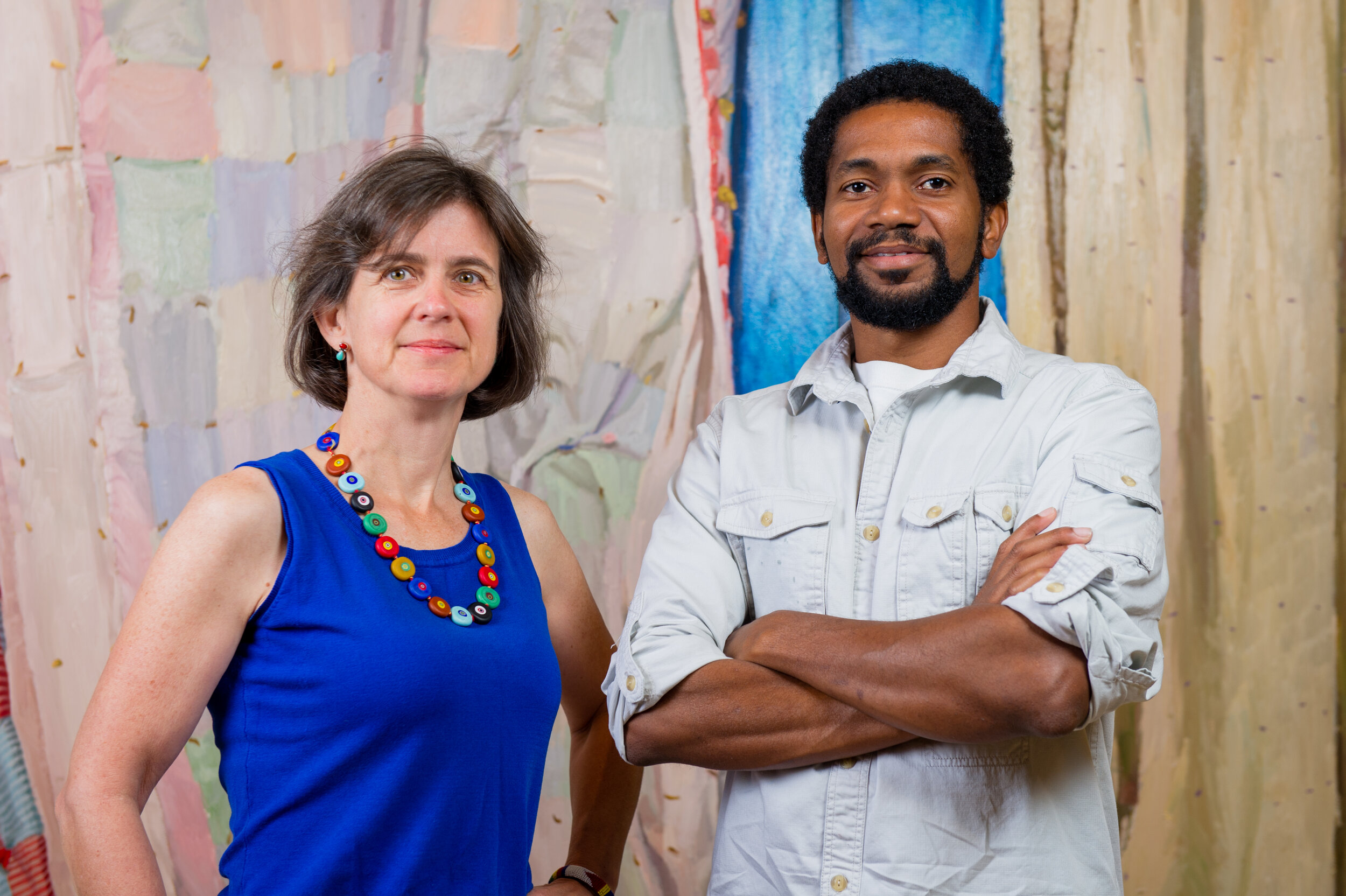
I had the pleasure of working with Sedrick Huckaby on two exhibitions of his work. His quilt-inspired work and dense, painterly surfaces, and connection to community continue to inspire me. In the photo above, we are standing in front of one of his mural-sized canvases, Winter, from the series A Love Supreme 2001–2009.
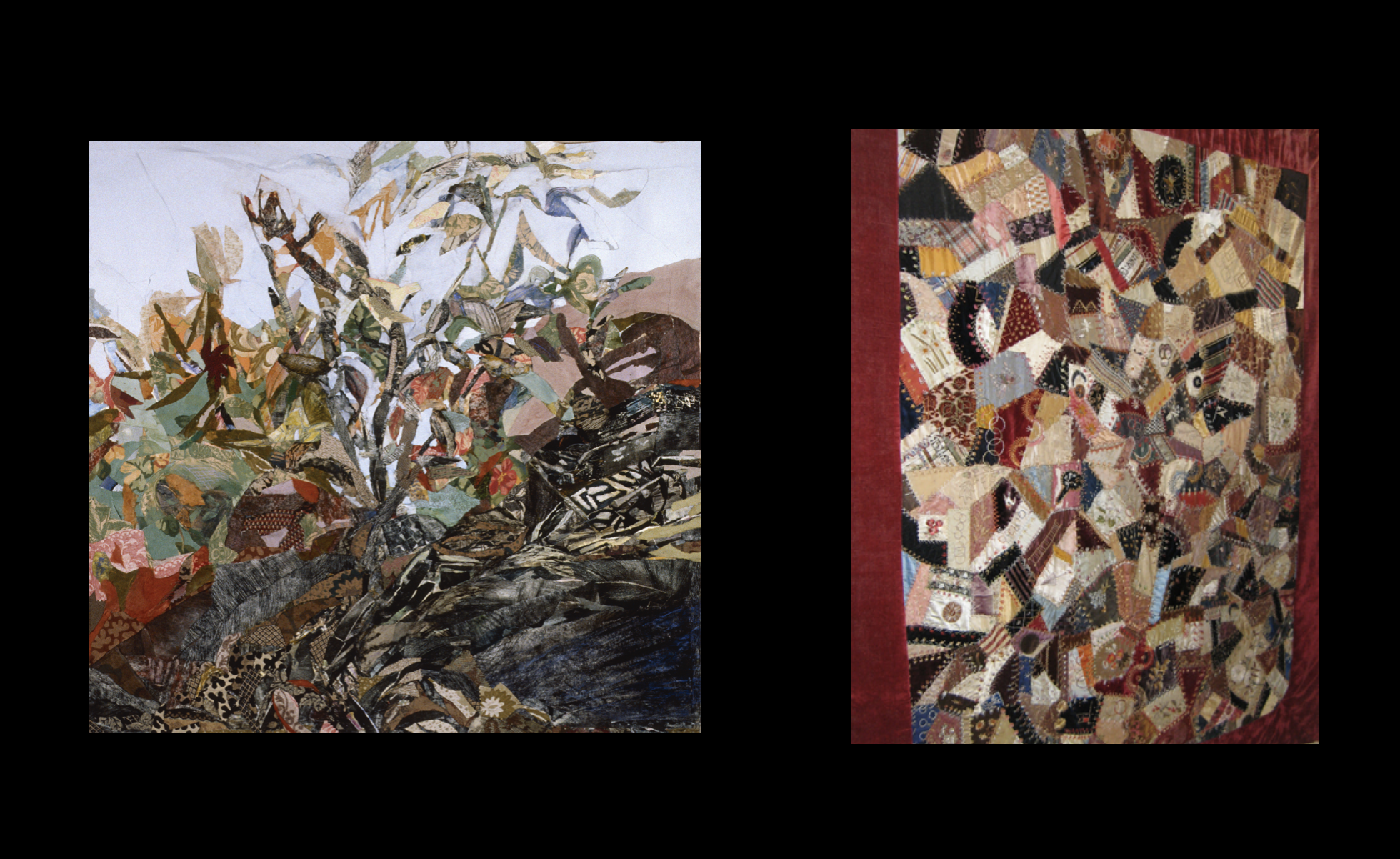
I grew up admiring my great-grandmother’s crazy quilt, which she made with a circle of friends in the late 1800s. For the past 30 years, I’ve been a member of a quilting group that meets regularly to quilt and share insights and support along with repurposed fabric. Cornucopia, the collage shown above left, was one of my first works in which elements of fabric played an important role.
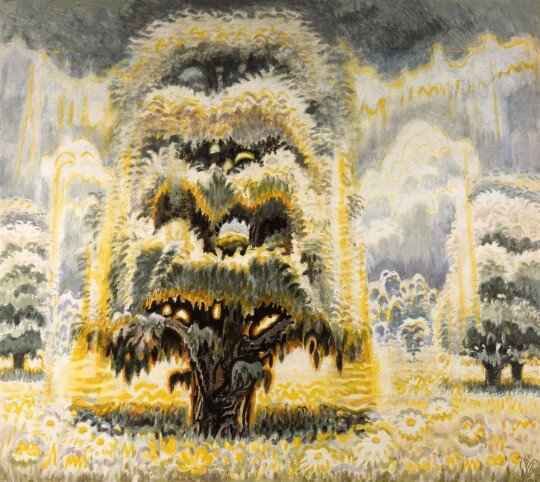
Since I can remember admiring notable artists, I have admired Charles Burchfield, especially his late watercolors. Works like the one above convey nature’s mystery and dynamism. Burchfield was interested in pattern (he designed wall paper for a living), and explored commonalities between music and art. I often think of his distinctive and rhythmic approach to space and mark making.

Thanks to Don Kimes, I had the good fortune to study with Rackstraw Downes in graduate school. Years later, I was able to curate Rackstraw Downes: A Wider View, a mini-survey of his work for the List Gallery, Swarthmore College. His painting has always been attentive to specificity, structure, proportion, and the complex relationships between humans and the environment. As both a critic and artist, he has always been a paragon of excellence.

I have been part of a quilting group for 30 years. Because of this, I fabric scraps were always in my studio and I ended up incorporating them into my collage art works. I am fascinated by the way fabric implicitly conveys communal values and resources. I admire the expressive abstract quilts made by Gee’s Bend, Alabama artists and am inspired by the way their designs embody jazz rhythms, improvisational strategies, and creative resilience. In 2018, I began researching and writing about quilts and etchings by Mary Lee Bendolph, one of Gee's Bend's most distinguished artists. Getting to know Mary Lee and her family, especially Rubin Bendolph Jr. and his sister, Essie Bendolph Pettway, reinforced my love of the way fabric provides a dynamic and resonant visual experience that cannot be reproduced digitally. I am inspired by many repurposed materials, be they discarded woodcut prints, outgrown clothing, or handwoven scarves, and I pay attention to the way materials can convey specific cultural associations. But because we wear fabric every day, we have a particularly visceral response to it. We intuitively grasp whether it is machine made or hand sewn, frivolous or frugal, new or antique. Many of the materials I use were given to me by other artists, educators, close friends, and family members. Synthesizing “high” and “low,” past and present, self with community, I hope to provide visual journeys that are infused with empathy, memory, and reconnection.
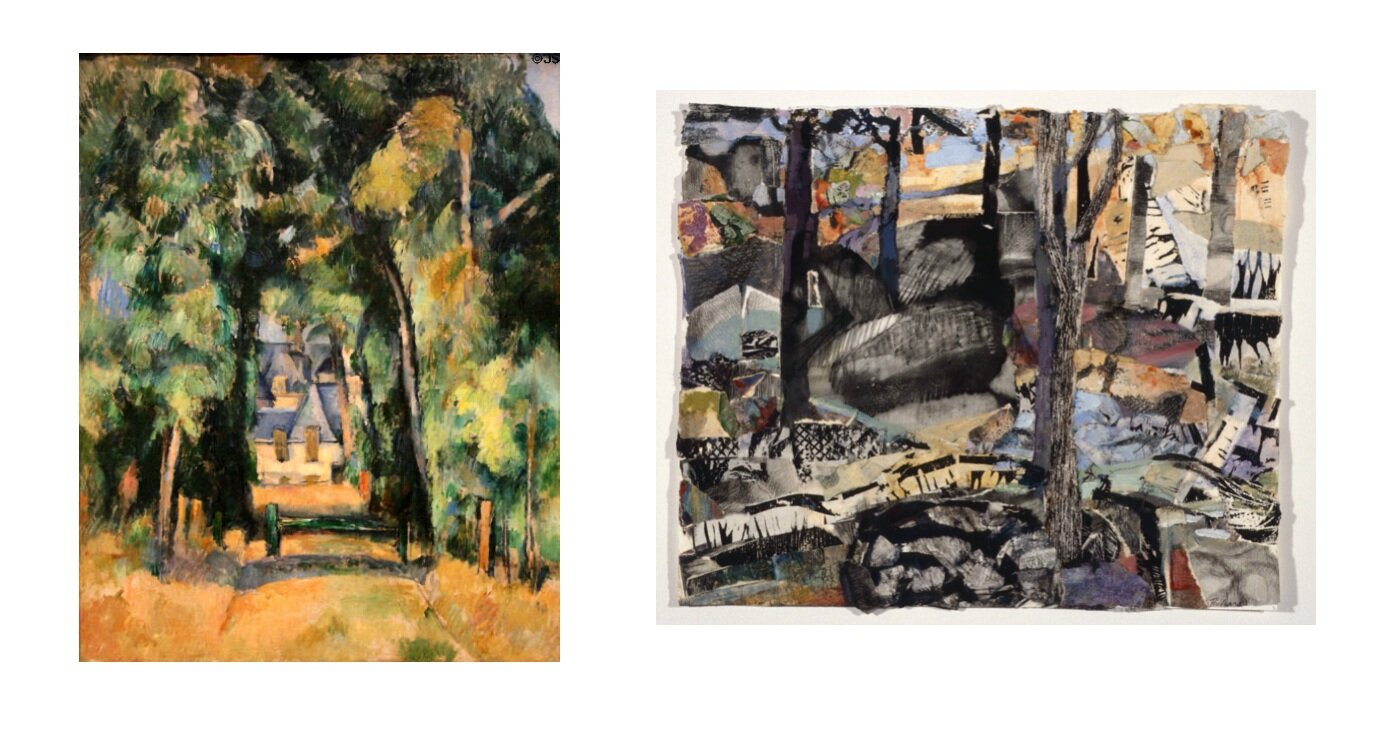
Cezanne. Of course.

Craig Stover’s interview with Andrea Packard about her inspirations, creative strategies, and more.












In July 2018, I traveled to Gee’s Bend, Alabama to research an exhibition, Piece Together: The Quilts of Mary Lee Bendolph. Mary Lee stands outside her home with two of her children, Rubin Bendolph Jr., and Essie Bendolph Pettway. Essie’s quilts hang on a clothesline behind them.
One of the first exhibits I curated included works by Alice Lok Cahana. Her work bore witness to her experience of surviving concentration camps during the Holocaust and her art was a kaddish for those who did not survive. She communicated that experience to others in ways that were beautiful enough for people to endure. Rather than aestheticizing violence, she used the language of art to engage others. Her mixed-media collages, they don’t preach, yet they convey her profound experience and enduring resilience. Shown above: Cahana’s painting, Waiting for the Magic Bird, acrylic and mixed media on canvas, 84 x 80 inches.
I worked with Emmet Gowin on exhibitions of his photographs at two different venues. His intimate portraits of his family life broadened the conversation about photography in the 1970s. When I hosted a mini-retrospective of his work at the List Gallery, I especially admired his ability to shift his modes of representation. The empathy that he communicated in his family portraits later became apparent in his aerial photographs of sites where human intervention have created toxic conditions.. For instance, he documented the Nevada Proving Ground where we’ve detonated hundreds of atomic explosions, turning the landscape into a kind of moonscape, forever altering the geology of the land. And then, in more recent works, he provides wonderful, intimate, microcosms of nature: he’s inventoried hundreds of moths from Panama, many of them endangered species, and some of them never photographed before. I try to emulate such imaginative elasticity, empathy, and dedication. On the right is Inheritance, a work that took inspiration from Gowin’s aerial perspectives.
Orit Hofshi and I attended The Pennsylvania Academy of the Fine Arts together many years ago and we both studied woodcut printmaking together. She’s gone on to become an internationally renowned sculptor and printmaker who integrates two-dimensional and three-dimensional practices in her work. After she showed here I went back to my studio and made a six-foot-wide wood carving. It was very different from her work aesthetically, but she had reawakened my love of wood.
I have taken inspiration from Romare Bearden who, in turn, took inspiration from Cezanne, among others. The above art work is my own homage to Bearden. I am curious about how to harmonize different influences–how one aesthetic can help transform another. For example, I am fascinated by the way introducing fabric into a work might change the way we experience space. Or introducing a different medium like pastel into a painting can evoke a shift in perception. Conversations between different aesthetics, inspirations, and media can echo the way consciousness is multilayered. It’s not unified by a single mode or look or source. It’s an elastic process of shifts through which we see, revise, and recreate the world around us.
I had the pleasure of working with Sedrick Huckaby on two exhibitions of his work. His quilt-inspired work and dense, painterly surfaces, and connection to community continue to inspire me. In the photo above, we are standing in front of one of his mural-sized canvases, Winter, from the series A Love Supreme 2001–2009.
I grew up admiring my great-grandmother’s crazy quilt, which she made with a circle of friends in the late 1800s. For the past 30 years, I’ve been a member of a quilting group that meets regularly to quilt and share insights and support along with repurposed fabric. Cornucopia, the collage shown above left, was one of my first works in which elements of fabric played an important role.
Since I can remember admiring notable artists, I have admired Charles Burchfield, especially his late watercolors. Works like the one above convey nature’s mystery and dynamism. Burchfield was interested in pattern (he designed wall paper for a living), and explored commonalities between music and art. I often think of his distinctive and rhythmic approach to space and mark making.
Thanks to Don Kimes, I had the good fortune to study with Rackstraw Downes in graduate school. Years later, I was able to curate Rackstraw Downes: A Wider View, a mini-survey of his work for the List Gallery, Swarthmore College. His painting has always been attentive to specificity, structure, proportion, and the complex relationships between humans and the environment. As both a critic and artist, he has always been a paragon of excellence.
I have been part of a quilting group for 30 years. Because of this, I fabric scraps were always in my studio and I ended up incorporating them into my collage art works. I am fascinated by the way fabric implicitly conveys communal values and resources. I admire the expressive abstract quilts made by Gee’s Bend, Alabama artists and am inspired by the way their designs embody jazz rhythms, improvisational strategies, and creative resilience. In 2018, I began researching and writing about quilts and etchings by Mary Lee Bendolph, one of Gee's Bend's most distinguished artists. Getting to know Mary Lee and her family, especially Rubin Bendolph Jr. and his sister, Essie Bendolph Pettway, reinforced my love of the way fabric provides a dynamic and resonant visual experience that cannot be reproduced digitally. I am inspired by many repurposed materials, be they discarded woodcut prints, outgrown clothing, or handwoven scarves, and I pay attention to the way materials can convey specific cultural associations. But because we wear fabric every day, we have a particularly visceral response to it. We intuitively grasp whether it is machine made or hand sewn, frivolous or frugal, new or antique. Many of the materials I use were given to me by other artists, educators, close friends, and family members. Synthesizing “high” and “low,” past and present, self with community, I hope to provide visual journeys that are infused with empathy, memory, and reconnection.
Cezanne. Of course.
Craig Stover’s interview with Andrea Packard about her inspirations, creative strategies, and more.
